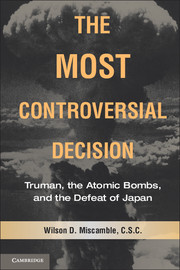Book contents
- Frontmatter
- Contents
- Acknowledgments
- Map 1 The Atomic Bombing of Japan
- Introduction: The Most Controversial Decision
- 1 Franklin Roosevelt, the Manhattan Project, and the Development of the Atomic Bomb
- 2 Harry Truman, Henry Stimson, and Atomic Briefings
- 3 James F. Byrnes, the Atomic Bomb, and the Pacific War
- 4 The Potsdam Conference, the Trinity Test, and Atomic Diplomacy
- 5 Hiroshima, the Japanese, and the Soviets
- 6 The Japanese Surrender
- 7 Necessary, But Was It Right?
- 8 Byrnes, the Soviets, and the American Atomic Monopoly
- 9 The Atomic Bomb and the Origins of the Cold War
- Suggested Readings
- Index
1 - Franklin Roosevelt, the Manhattan Project, and the Development of the Atomic Bomb
Published online by Cambridge University Press: 05 June 2012
- Frontmatter
- Contents
- Acknowledgments
- Map 1 The Atomic Bombing of Japan
- Introduction: The Most Controversial Decision
- 1 Franklin Roosevelt, the Manhattan Project, and the Development of the Atomic Bomb
- 2 Harry Truman, Henry Stimson, and Atomic Briefings
- 3 James F. Byrnes, the Atomic Bomb, and the Pacific War
- 4 The Potsdam Conference, the Trinity Test, and Atomic Diplomacy
- 5 Hiroshima, the Japanese, and the Soviets
- 6 The Japanese Surrender
- 7 Necessary, But Was It Right?
- 8 Byrnes, the Soviets, and the American Atomic Monopoly
- 9 The Atomic Bomb and the Origins of the Cold War
- Suggested Readings
- Index
Summary
Harry Truman bore the ultimate responsibility for the use of the atomic bombs, but the American decision to develop these weapons for use in World War II was made by Franklin Roosevelt. Truman's predecessor is a dominant political figure of the twentieth century. His place in American history rests secure as a great leader in peace and war, a brilliant political practitioner, and the measuring rod for all subsequent presidents. In the depths of depression he helped restore to an almost despairing nation real hope and energy with his New Deal measures. He overcame the powerful forces of American isolationism and unilateralism in the years from 1939 to 1941 and supported Great Britain and the Soviet Union in their deathly struggle against Hitler's Germany. After Pearl Harbor he convinced the American people that they faced a truly global challenge, which required the defeat of both Germany and Japan. He led a unified nation through to the brink of ultimate victory in the greatest armed conflict in history.
Yet, when examining Roosevelt's portrait more closely and beyond the broad brush strokes formed by his buoyant leadership of his nation through the Depression and the Second World War, his picture becomes more blurred. Roosevelt might best be thought of as a remarkable exemplar of the “political fox” in action. He was never limited by any central conviction or purpose.
- Type
- Chapter
- Information
- The Most Controversial DecisionTruman, the Atomic Bombs, and the Defeat of Japan, pp. 5 - 19Publisher: Cambridge University PressPrint publication year: 2011



